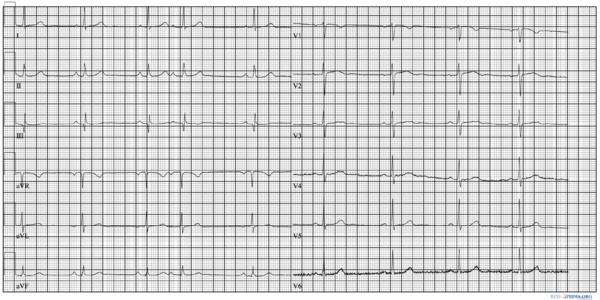Atrial Premature Complexes: Difference between revisions
mNo edit summary |
mNo edit summary |
||
| (5 intermediate revisions by the same user not shown) | |||
| Line 2: | Line 2: | ||
[[Image:Rhythm_premature.png|thumb| A premature atrial complex (PAC). (In this example the atrial p-wave is difficult to discern).]] | [[Image:Rhythm_premature.png|thumb| A premature atrial complex (PAC). (In this example the atrial p-wave is difficult to discern).]] | ||
[[Image:Bes.png|thumb| A premature atrial complex (PAC) with evident negative p-wave]] | [[Image:Bes.png|thumb| A premature atrial complex (PAC) with evident negative p-wave]] | ||
[[File:AES.svg|thumb|This ladder diagram shows the three possible faits of an atrial premature complex. First two normal sinus beats are shown. The first atrial extrasystole is conducted normally. The second atrial extrasystole follows the previous sinus beat a bit earlier and is conducted with [[RBBB]] aberration. The third atrial extrasystole is still a bit earlier after the previous sinus beat and is blocked in the AV node and therefore not-conducted | [[File:AES.svg|thumb|This ladder diagram shows the three possible faits of an atrial premature complex. First two normal sinus beats are shown. The first atrial extrasystole is conducted normally. The second atrial extrasystole follows the previous sinus beat a bit earlier and is conducted with [[RBBB]] aberration. The third atrial extrasystole is still a bit earlier after the previous sinus beat and is blocked in the AV node and therefore not-conducted, resulting in a P wave, but no QRS complex, followed by a [[Ectopic Beats|noncompensatory pause]].]] | ||
[[File:E000602.png|thumb|A 12 lead ECG with a atrial extrasystole. The fourth QRS complex is preceded by an AES]] | |||
Premature atrial complexes origin from an ectopic pacing region in the atria. They are an example of [[Ectopic Beats|ectopic beats]]. The result is a p-wave with often a different morphology from the preceding ones. | Premature atrial complexes origin from an ectopic pacing region in the atria. They are an example of [[Ectopic Beats|ectopic beats]]. The result is a p-wave with often a different morphology from the preceding ones. | ||
If a premature atrial complex follows early after a previous sinus beat some of the the conducting tissues below may not conduct. A premature atral complex can therefore have different fates (see figure): | |||
# Normally conducted | |||
# Conducted with aberrancy. Mostly right bundle branch block aberrancy as the RBBB has a longer refractory period. | |||
# Non-conducted. If the premature beat is very early, the AV node is refractory (cannot conduct) and the beat is not followed by a QRS complex. A non-conducted premature atrial beat is often confused with type II second degree AV block where a normal sinus beat is not followed by a QRS complex. | |||
A premature atrial complex is usually followed by a [[Ectopic Beats|noncompensatory pause]] caused by the fact that atrial depolarization enters the sinus node and resets the sinus rhythm. | A premature atrial complex is usually followed by a [[Ectopic Beats|noncompensatory pause]] caused by the fact that atrial depolarization enters the sinus node and resets the sinus rhythm. | ||
Premature atrial complexes are common and usually benign. | Premature atrial complexes are common and usually benign. Frequent atrial ectopic beats (>100 / 24hrs) in a population of patients presented to a cardiovascular hospital wass associated with a small chance of 1% of developing atrial fibrillation in the following year <cite>AES</cite> | ||
'''See also:''' | '''See also:''' | ||
| Line 14: | Line 20: | ||
{{clr}} | {{clr}} | ||
==References== | |||
<biblio> | |||
#AES pmid=23499279 | |||
</biblio> | |||
Latest revision as of 20:36, 23 June 2013
| This is part of: Supraventricular Rhythms |




Premature atrial complexes origin from an ectopic pacing region in the atria. They are an example of ectopic beats. The result is a p-wave with often a different morphology from the preceding ones.
If a premature atrial complex follows early after a previous sinus beat some of the the conducting tissues below may not conduct. A premature atral complex can therefore have different fates (see figure):
- Normally conducted
- Conducted with aberrancy. Mostly right bundle branch block aberrancy as the RBBB has a longer refractory period.
- Non-conducted. If the premature beat is very early, the AV node is refractory (cannot conduct) and the beat is not followed by a QRS complex. A non-conducted premature atrial beat is often confused with type II second degree AV block where a normal sinus beat is not followed by a QRS complex.
A premature atrial complex is usually followed by a noncompensatory pause caused by the fact that atrial depolarization enters the sinus node and resets the sinus rhythm.
Premature atrial complexes are common and usually benign. Frequent atrial ectopic beats (>100 / 24hrs) in a population of patients presented to a cardiovascular hospital wass associated with a small chance of 1% of developing atrial fibrillation in the following year AES
See also:
References
<biblio>
- AES pmid=23499279
</biblio>